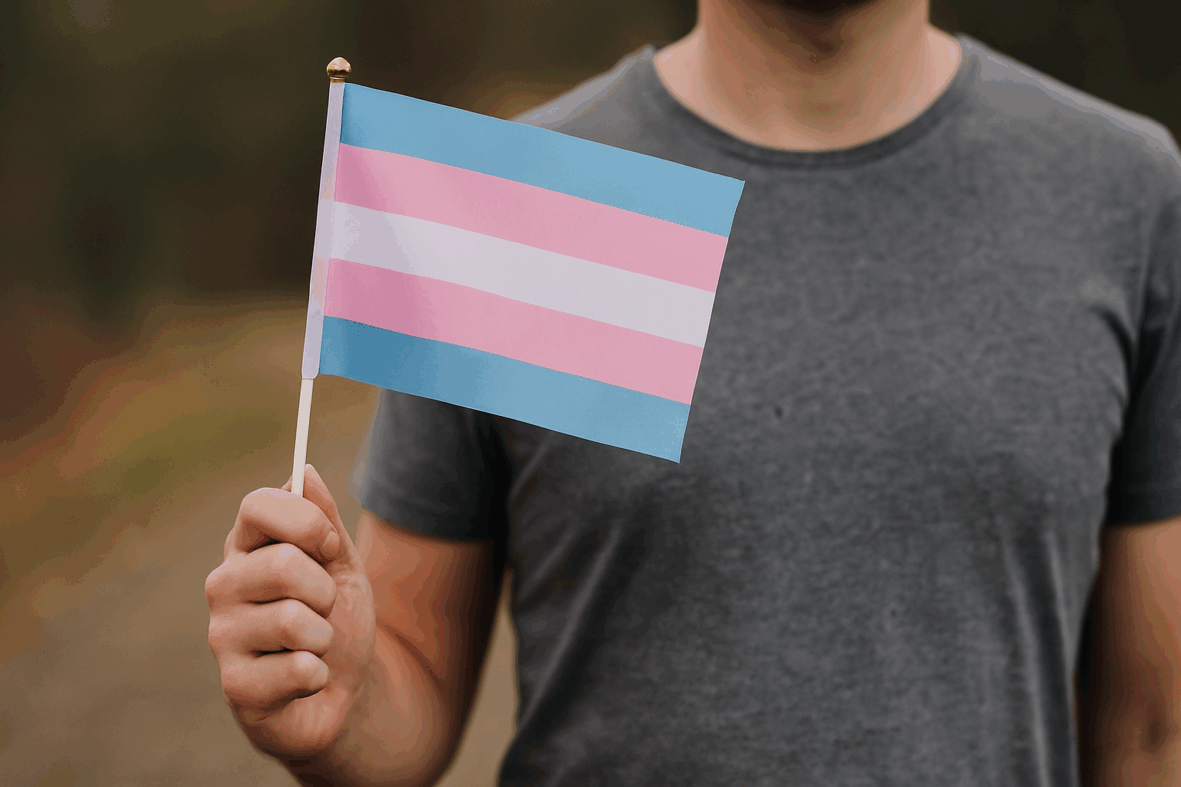Part 3 of Gender and Sexuality
Scripture: Psalm 139:14
“I will give thanks to You, for I am fearfully and wonderfully made; Wonderful are Your works, and my soul knows it very well.” (Psalm 139:14, LSB). With these poetic words, King David celebrates God’s intimate involvement in creating him. Every person is handcrafted by God, from the womb, with purposeful design. In today’s world, that truth is being challenged in an unprecedented way by the rise of transgender ideology – the belief that one’s gender identity can be different from one’s biological sex, and that one can redefine or even physically alter oneself to match that inner identity. How should Christians respond to this phenomenon? With the same balance of compassion and conviction that we’ve discussed earlier in this series. Transgender individuals often experience deep pain and confusion; they need the compassionate care of Christians. Yet the movement of “transgenderism” (as an ideology) promotes claims about human nature that conflict with biblical truth. We cannot compromise the truth that our Creator fearfully and wonderfully made us male or female for His glory. In this post, we will explore what the Bible says about gender identity, examine the gospel’s answer to our identity struggles, and consider how to lovingly walk with those who experience gender dysphoria. All the while, we’ll keep in mind the spiritual warfare element – the enemy’s strategy to twist human identity – as illuminated by Michael Heiser’s The Unseen Realm (2015). Our aim is a response to transgender issues that is biblically faithful, scientifically informed, and pastorally gentle, grounded in the truth of Psalm 139:14 and other Scriptures.
Fearfully and Wonderfully Made: God’s Design for Gender (Psalm 139:14)
Psalm 139 is a beautiful meditation on God’s omniscience and care in the creation of a human life. David marvels at how God “formed my inward parts; You wove me in my mother’s womb” (Psalm 139:13). In verse 14 he exclaims that he is “fearfully and wonderfully made” – a truth that applies to each one of us. God does not create generic humans; He designs each person with intention. This includes the gift of our biological sex. Our male or female body is not an accident or a mere shell; it is an integral part of who we are as God’s image-bearers. The creation account affirms this by stating “male and female He created them” in His image (Genesis 1:27). Thus, the biblical worldview is incarnational and holistic – body and soul together make us who we are (Matthew 10:28). The Christian doctrine of the resurrection further underscores the importance of our bodies: God will redeem and resurrect our bodies, not discard them (Romans 8:23).
Applying this to the transgender question: if someone feels a conflict between their inner sense of gender and their biological sex, the starting truth is that God did not make a mistake in their physical sex. Their body, including their chromosomes and reproductive anatomy, is part of God’s “wonderful” work in creating them. To believe otherwise is to fall into a tragic misunderstanding of one’s self. We empathize with the distress that person may feel (a condition often termed gender dysphoria), but we affirm on the authority of Scripture that embracing one’s God-given sex is ultimately part of God’s good plan for that individual. In Psalm 139:16, David says, “Your eyes have seen my unformed substance; and in Your book were all written the days that were ordained for me.” God’s sovereignty extends to our identity; He ordains our days and forms us with intentionality.
Consider how this truth speaks hope: a person struggling with their gender can find rest in knowing they are known and loved by their Creator, who fashioned them intentionally. Rather than needing to sculpt themselves into a new identity, they can seek to discover God’s purpose for who they already are. Pastorally, when walking through Psalm 139 with someone experiencing dysphoria, we might say: “God sees you, He knows you inside and out (Ps 139:1–4), and He made you with love. Your body is not an error – it’s a gift, even if it’s hard to feel that way right now.” This doesn’t instantly erase the dysphoria, but it lays a foundation of truth and dignity upon which healing can be built.
We must also clarify what transgenderism means in our current context. The term “transgender” is an umbrella for many experiences, but generally it refers to someone whose internal sense of gender (gender identity) does not align with their biological sex, and who may take social, hormonal, or surgical steps to present as the opposite sex (or as no gender, in some cases). This is distinct from sexual orientation – it’s not about whom one is attracted to, but about who one feels oneself to be in terms of male or female. It’s also distinct from rare intersex conditions (disorders of sexual development, such as androgen insensitivity syndrome or chromosomal anomalies), which involve ambiguous biology. The vast majority of transgender-identifying individuals have normal, healthy male or female bodies; their conflict is psychological.
Understanding these distinctions is important. Someone who genuinely experiences gender dysphoria is typically not sinning by having those feelings – the feelings often arise involuntarily (like any psychological struggle as a result of the Fall). The ideology of transgenderism, however, steps in and suggests a solution that contradicts God’s order: namely, that the mind is right and the body is wrong, so the body must be altered or daily reality denied to match the mind. It often encourages a person to identify primarily by their dysphoric feelings (“I am a man in a woman’s body,” etc.), rather than seeing those feelings as part of a broken condition to be compassionately addressed. This ideology has become very influential, leading to what some have called a social contagion of transgender identification, especially among teens. In a short span of years, notions that were fringe (like attempting to change one’s sex) have become mainstream, promoted even in children’s education and media. This is the cultural landscape we find ourselves in – one that can be confusing and intimidating for Christians who uphold biblical teaching.
So what does the Bible teach about gender identity? In a nutshell: Gender is not a personal construct or feeling; it is a God-given reality, rooted in biology and creation. Scripture consistently treats being male or female as something fundamental to personhood, established by God (Genesis 1:27, Matthew 19:4). There is never a hint that someone’s gender could be different from their biological sex – the two are inseparably one. As theologian Wayne Grudem puts it, “There is no hint anywhere in Scripture that a biological woman should ‘identify’ as a man… And there is no hint anywhere in Scripture that a biological man should ‘identify’ as a woman” (Grudem, 2018, p. 882). In fact, the Bible contains an explicit prohibition in Deuteronomy 22:5: “A woman shall not wear a man’s clothing, nor shall a man put on a woman’s clothing; for whoever does these things is an abomination to Yahweh.” While this Old Testament law was given to Israel and Christians are not under the Mosaic law as civil code, the principle it reflects is revealing – God expects a distinction between the sexes to be honored. Old Testament scholar Jason DeRouchie notes that this law presupposes “a more fundamental rule – that there are only two biological sexes – male and female – and that one’s biological sex should govern both one’s gender identity and expression” (DeRouchie, 2020, p. 223). Even though we are not bound to ancient Israel’s dress codes, the underlying creation principle remains: it is against God’s order to blur or erase the distinctions He built into male and female.
Another relevant biblical passage is 1 Corinthians 11:14–15, where Paul appeals to the Corinthian church about hair length customarily reflecting gender distinctions, saying nature itself teaches a difference between masculine and feminine presentation. The specifics of hair length are cultural, but Paul’s reasoning again assumes that embracing and honoring one’s biological sex is the norm (“nature”) and is proper in worship. Furthermore, in 1 Corinthians 6:9, among the list of sins, Paul uses the term malakoi (often translated “effeminate” or “men who practice homosexuality” in context). The word literally means “soft men” and likely refers to men in homosexual relations who took the culturally feminine role. Some scholars also see an application to men who intentionally feminized themselves. In any case, the Bible would see today’s practice of a man publicly living as a woman (or vice versa) as a violation of God’s design, in the same moral category as other sexual sins.
These scriptural truths present a big challenge: What do we do with a person who genuinely feels at odds with their own sex? Telling them “just accept it” may seem too simplistic, given the psychological anguish many describe. Here is where Christian theology of the Fall helps. The Bible teaches that we live in a fallen world where our bodies and minds are subject to brokenness (Genesis 3, Romans 8:20–22). That includes all manner of conditions: depression, anxiety, schizophrenia, eating disorders where one’s body image is distorted, and yes, gender dysphoria – a distress at one’s sexed body or a persistent feeling of identifying as the opposite sex. We acknowledge this suffering as real. It is part of the groaning of creation. But our response to any result of the Fall is not to affirm the distortion as good; it’s to seek redemption and restoration. For example, if a person has body integrity identity disorder (a rare condition where they feel like an amputee in a healthy body and desire amputation), the compassionate response is not to cut off their healthy limb. It is to provide compassionate counseling and therapy to help their mind reconcile with reality, while loving them through their struggle. In a parallel (though not identical) way, if someone born male feels they are or should be female, true compassion tries to help the person align their inner identity with the reality of their body, not alter the body (which is healthy and functioning as designed) to match the inner feeling. As Christian ethicist Andrew Walker writes, “our bodies are a gift and are intended to inform and guide our self-conception, rather than be negated by it” (Walker, 2017, p. 85).
Identity in Truth: The Gospel and the True Self
At the heart of the transgender discussion is the question of identity. “Who am I, really?” The culture answers: “You are who you feel yourself to be on the inside; your psychological self is the ‘real’ you. The external (even your body) is secondary.” But the Bible answers: “You are who God made you to be (His image-bearer, either male or female), and for believers, you are who God has redeemed you to be in Christ (a child of God, a new creation).” This is a clash of worldviews. As Carl Trueman has shown, modern Western society exalts expressive individualism – the idea that the purpose of life is to discover and express your unique feelings and desires, and that any external norms that constrain those expressions are oppressive (Trueman, 2022, pp. 19–21). In this mindset, if a person feels internally that they are a woman, then that feeling defines reality for them, and society is expected to honor and affirm that self-definition. However, from a Christian perspective, our feelings, while significant, are not infallible guides to truth. In fact, Scripture often warns that our hearts can be deceptive or confused (Jeremiah 17:9). We need an external reference point – God’s revelation – to tell us who we are.
The Gospel provides the ultimate answer to identity confusion. In Christ, we discover an identity more fundamental than our gender, sexuality, or any other human label: we become children of God (John 1:12), and our identity is “in Christ.” 2 Corinthians 5:17 declares, “if anyone is in Christ, he is a new creation; the old things passed away; behold, new things have come.” This means that for someone who comes to Jesus, the truest thing about them is no longer their sinful tendencies, their past, or even their personal self-conception – the truest thing is that they belong to Jesus. They have a new identity given by grace, not achieved by self-will. The journey of the Christian life (sanctification) is then to bring our thoughts, desires, and behaviors into alignment with that new identity in Christ (Ephesians 4:22–24).
How does this apply to a person who is transgender? It means that, if that person turns to Christ in faith, they are first and foremost a Christian – a follower of Jesus – and that identity carries greater weight than “transgender” or any other descriptor. Over time, as they grow in understanding God’s truth, they would begin to see themselves as God’s beloved son or daughter. The term “transgender Christian” would ultimately be a misnomer; the goal would be simply “Christian,” living in conformity to Christ. Now, this does not mean that all dysphoric feelings instantly vanish at conversion. Just as, say, a new Christian who was an alcoholic may still struggle with urges to drink, a new Christian who felt gender dysphoria may still experience those feelings. But their approach to those feelings changes: instead of embracing a transgender identity, they seek Christ’s strength to live in the identity He assigns – either living as a man or woman according to their God-given sex, trusting that He can give grace to accept themselves and find purpose in that. It becomes an issue of discipleship and growth in truth.
One key biblical principle is the call to self-denial in following Jesus. Jesus said, “If anyone wants to come after Me, he must deny himself, take up his cross daily, and follow Me” (Luke 9:23). Our culture today preaches “assert yourself”, but Jesus preaches “deny yourself.” There is a cost to discipleship that includes surrendering even deeply held feelings or identities to Christ’s lordship. For a transgender individual, this may feel like a huge ask – to deny what feels like their very identity. However, Jesus also assures us that whoever loses their life for His sake will find it (Matthew 16:25). In other words, in dying to our self-defined identity, we find a truer, richer identity in Him. Many who have detransitioned or left transgender lifestyles testify that while it was difficult, they eventually found much greater peace living in alignment with their birth sex and embracing Christ’s vision for their life, compared to the never-ending anxiety of maintaining a transgender persona.
It’s worth noting: not every person who experiences gender dysphoria will have a neat resolution of feelings. Some faithful Christians might continue to feel an internal sense of incongruence for a long time (just as some continue to feel same-sex attraction or other unwanted conditions). The gospel doesn’t promise immediate emotional realignment; it promises sufficient grace. Paul, when pleading for a “thorn in the flesh” to be removed, was told by God, “My grace is sufficient for you, for power is perfected in weakness” (2 Corinthians 12:9). The church should be prepared to support someone in the long haul of obedience even when the feelings persist. This might include counseling, support groups, and consistent affirmations of the person’s decision to honor God with their body. We should also be patient – identity struggles run deep, and it may take time for someone to unlearn the lies of the world and know in their soul that they are indeed “fearfully and wonderfully made” as Psalm 139 says.
A big part of that learning is the renewing of the mind by Scripture (Romans 12:2). Ephesians 4:22–24 speaks of being “renewed in the spirit of your mind” and putting on the new self in God’s likeness. When counseling a believer coming out of transgender identity, immersing them in what God’s Word says about them is crucial. Passages like Psalm 139, Ephesians 1 (which lists our spiritual blessings and identity in Christ), 1 Peter 2:9–10 (declaring us a chosen people, God’s own possession), and 1 Corinthians 6:19–20 (reminding us our body is a temple of the Holy Spirit and we are not our own) all reinforce a God-centric identity. Over time, the hope is that their soul “knows it very well” (Ps 139:14b) that God’s works – including their sex and personhood – are wonderful.
Let’s also consider science and truth. Biological truth aligns with biblical truth here: every cell in our body (except reproductive cells) carries either an XX (female) or XY (male) chromosome pair. Our bodies are dimorphic; hormones and physiology align with those chromosomal realities. While surgeries and hormones can artificially alter appearance, they cannot change a person’s sex imprinted in DNA. Even the capability for reproduction (absent extreme interventions) remains with the birth sex – trans men (biological females) do not produce sperm; trans women (biological males) do not produce ova or carry babies. In short, sex is an immutable trait. As one author bluntly stated, “There’s no such thing as a ‘sex change’ – what happens is a cosmetic approximation of the opposite sex” (MacArthur, 2022). This might sound harsh, but it’s factual. A person born male will die male; a person born female will die female, regardless of interventions. A Christian approach can use these truths kindly: helping someone see that their maleness or femaleness is a given (a reality to be accepted) rather than a choice.
However, we must wield such truth with compassion. Often by the time someone is considering or pursuing gender transition, they have gone through intense internal turmoil. They may have latched onto transition as the only hope for relief. If we simply throw facts at them (“you’re XY, accept it!”) without walking alongside them empathetically, we will likely push them away. Truth must be coupled with relationship. For instance, a detransitioned woman named Laura might share how at first she resented Christians who told her “God made you female” – but what ultimately reached her was a Christian friend who constantly reminded her, “I love you, and I believe God has good plans for your life as the woman He created you to be,” and stuck with her even as she went through with transition. Over time, God used that faithful presence and prayer to draw Laura to Himself, and she eventually realized transitioning hadn’t delivered the peace she sought. She began to embrace her birth sex again, and that friend and church community walked with her through the difficult detransition process. This scenario (a composite drawn from various real testimonies) highlights that patience and persistent love are key. Identity change – at the deepest level – is often a slow journey, akin to what the Bible calls the process of sanctification.
Walking with Those Who Struggle: Grace and Truth in Community
How can churches practically minister to individuals and families dealing with transgender issues? Several pastoral strategies emerge:
1. Cultivate an environment of truth and grace. Churches should teach clearly on God’s design for gender (so people aren’t confused about where the church stands), but also convey that anyone who is struggling with their gender or sexuality is welcome to come and seek help. In many cases, youth in churches who have gender confusion keep it secret for fear of rejection. We must dispel that fear by how we talk about the issue. For example, a pastor can say in a sermon, “If you’re wrestling with your gender identity, I want you to know this church cares about you. We might not fully understand what you’re feeling, but we want to walk with you and point you to the hope in Christ.” That kind of statement can open a door for someone to approach a leader later.
2. Prioritize listening and mental health support. When someone shares that they feel like the opposite gender, it’s crucial to listen without panic or immediate judgment. Ask questions kindly: “How long have you felt this way? What factors seem to intensify or alleviate those feelings? Are there other stresses in your life?” Gender dysphoria often coexists with other issues like depression, anxiety, or trauma. A study in the Journal of the American Medical Associationfound high rates of mental health issues among transgender-identifying youth. Rather than assuming immediate motives or sin, a wise approach is to involve wise counselors or therapists (ideally Christian or at least respectful of Christian values) to evaluate what’s underneath the surface. Sometimes gender dysphoria can be a symptom of something else (family dynamics, social isolation, sexual abuse, etc.). Treating those underlying issues can reduce the dysphoria. The church can offer to help connect individuals or parents with counselors, and provide support (possibly even financial help) for therapy if needed. This is part of bearing one another’s burdens (Galatians 6:2).
3. Encourage slow, thoughtful decision-making. In today’s climate, many are fast-tracked into transitioning (even teenagers, through hormones or name changes) without addressing underlying factors. A compassionate but truth-informed Christian stance would be: “Let’s slow down.” Advise the person (or parents, if a minor) to avoid irreversible steps and give time for reflection. It’s documented that the majority of children with gender dysphoria eventually reconcile with their biological sex by adulthood if not rushed into transition (Shrier, 2020, p. 51). Share stories of detransitioners – those who regret transitioning – to highlight that these feelings can change, but medical interventions often cannot be fully undone. The goal is to steer them away from drastic actions that could harm them long-term (Jesus taught us to love our neighbor, and that includes protecting them from self-harm where possible). All the while, assure them you will walk with them regardless of what they decide, but as a caring friend you urge caution.
4. Affirm their true identity and offer practical support. As a church community, find ways to integrate the person into healthy same-sex fellowship in their birth sex. For example, if a biological female named Taylor is struggling but has chosen to remain living as a woman, make sure the women’s group invites her in, mentors her, and affirms godly womanhood in diverse expressions. Sometimes stereotypes can make it hard – e.g., if Taylor is more stereotypically “masculine” in interests, the women must still embrace her as one of their own, showing that being female has a broad range and she doesn’t have to fit a narrow mold to be the gender God made her. The same for a sensitive artistic boy who thinks he must be a girl – the men in the church can intentionally show him he is valued and fully male even if he isn’t into sports or trucks. The church can be the place where God’s view of gender is modeled: equal worth, beautiful differences, but no rigid stereotypes that aren’t biblical (the Bible doesn’t say boys must like rough games or girls must play with dolls – those are cultural). This kind of embracing community can counteract the narrative that “if I don’t fit cultural norms, I must be the opposite gender.”
Practically, if someone has lived socially as the opposite gender and then reverts, support them through that transition. It can be awkward – they may need a new wardrobe, maybe even help legally changing documents back. Stand by them so they don’t feel alone or embarrassed. One church rallied around a young man who detransitioned by throwing a casual “welcome back [his name]” party, not to shame his past but to joyfully affirm him in his God-given identity, giving him symbolic gifts that celebrated his manhood in Christ. Such intentional acts communicate acceptance and joy, which is powerful.
5. Stand firm on truth in church practices. Compassion does not mean we bend God’s commands. If a person insists on identifying as transgender and demands the church approve, we must lovingly explain we cannot. For instance, a biological male who comes to church presenting as female should still be treated with love and respect, but we wouldn’t affirm a request to use the women’s restroom or join a women’s ministry as a “woman member,” because that would compromise others’ safety/comfort and endorse a falsehood. These situations can be delicate. Some churches offer a private restroom as an accommodation. The key is to communicate: “We want you here and will minimize discomfort, but we cannot lie about who you are.” Many trans-identifying persons may decide to leave a church that won’t affirm their transition; that is a reality we must accept, entrusting them to God’s continued work. Our hope is that by maintaining relationship as long as possible and keeping communication open, seeds of truth will be planted that may bear fruit later.
As we walk with individuals, let’s also zoom out to remember the cosmic perspective: We have an enemy who sows confusion and “steals, kills, and destroys” (John 10:10). The pain and even self-harm (in terms of unwanted surgeries, chemical castration, etc.) involved in transgender pursuits reflect that destructive intent. But Jesus continues in John 10:10, “I came that they may have life, and have it abundantly.” Our mission is to lovingly lead people to the abundant life that Jesus offers – a life lived in harmony with God’s creative intent and redeemed by His grace.
Spiritual Warfare: Resisting the Father of Lies
As with the LGBTQ+ issues at large, transgenderism is not just a social or medical issue – it’s deeply spiritual. There are forces of deception at work. In 1 Timothy 4:1, Paul warns that “in later times some will fall away from the faith, paying attention to deceitful spirits and doctrines of demons.” One could argue that the idea “you can be a different gender than your body” is a kind of modern “doctrine” that has an almost religious fervor behind it, brooking no dissent. It certainly qualifies as a deception, since it contradicts observable reality and biblical truth. We should therefore be on guard in prayer. Pray for discernment for our youth, who are bombarded by social media influencers glamorizing transition. Pray for protection of children from confusion. Pray against the spiritual strongholds that make these ideas seem so compelling and compassionate in the world’s eyes. And importantly, pray for the individuals by name that you know who are struggling, that any hold the enemy has on their mind would be broken. As Paul says, “though we walk in the flesh, we do not wage battle according to the flesh” (2 Corinthians 10:3). Arguments alone seldom win these battles – the Holy Spirit must “lead into all truth” (John 16:13).
Michael Heiser’s insights in The Unseen Realm remind us that the supernatural worldview of the Bible sees earthly conflicts mirroring heavenly ones. There is a cosmic battle over the image of God. When Satan tempted Eve, one could interpret it as an attack on the created order – he approached the woman to subvert the man’s headship, and enticed both into overturning God’s design. Similarly, the androgynous or gender-blending impulses in pagan cultures (and today) can be viewed as demonic attempts to deface the Creator’s artwork. Heiser (2015) points out that rebellious spiritual beings seek to usurp God’s glory by corrupting those who image God (pp. 41–45). So every time a person despairs over their sex or mutilates their healthy body, the enemy gains a small victory of disorder and pain. However, Christ came to destroy the works of the devil (1 John 3:8). Our confidence is that through Jesus, captives can be set free. We’ve heard of individuals who, after much prayer, suddenly experienced a breakthrough – an ability to accept themselves that they attribute to God freeing them from spiritual oppression or lies they had believed. We should not underestimate the power of prayer and even fasting in these particularly entrenched cases (Mark 9:29).
Spiritual warfare also means guarding ourselves and our families with truth. Ephesians 6 speaks of the armor of God – belt of truth, breastplate of righteousness, etc. Parents, for example, might need to proactively teach their children what the Bible says about being male and female from a young age, inoculating them against confusion. Churches can equip parents with age-appropriate resources to talk about these things. And when confronted with perhaps a mandate at work or school to use “preferred pronouns” or affirm statements we know are false, Christians must prayerfully decide how to stand on truth graciously. Some may comply in part to keep relational doors open; others may refuse to speak a lie, even facing consequences. This too is spiritual warfare – standing firm (Eph 6:13) when pressured to deny God’s truth about humanity. There is no one-size-fits-all answer, but each believer should seek the Lord’s wisdom and courage.
Finally, we battle spiritually by keeping the hope of the Gospel front and center. Our message is not “be cisgender like me, then you’ll be saved.” Our message is “be reconciled to God” (2 Corinthians 5:20) – receive a new heart. In that reconciliation, the gender identity issues will be addressed as part of God’s sanctifying work. The reason we care about truth is because lies enslave, but “where the Spirit of the Lord is, there is freedom” (2 Corinthians 3:17). We long for those struggling to find freedom in Christ – freedom from the need to self-define, freedom from painful striving to be someone else, freedom from the accusations of the devil. When someone does find that freedom, all of heaven rejoices, and so should we.
Conclusion: Speaking Truth, Showing Love, Offering Hope
Transgenderism is perhaps one of the most difficult and sensitive challenges the church has faced in our time. It raises profound questions about personal identity, suffering, and the authority of God’s creation order. Yet, we are not left without guidance. God’s Word gives us clear truth: He made humans male or female, our bodies are created by Him and for Him, and we find our true identity by surrendering to Christ. God’s character compels us to love: He is compassionate and gracious, calling us to imitate His love toward those who are hurting or deceived. And God’s power gives us hope: no one is beyond His reach, and His grace can transform even the most entrenched heart.
For the person experiencing gender dysphoria, the gospel offers an invitation: “Find your identity in the One who created you and died for you.” It may involve a hard road of denying oneself and trusting God’s design, but Jesus promises that whoever loses their life for His sake will find it (Matthew 16:25). There are increasing stories of people who transitioned and later found it didn’t bring the promised peace, but then encountered Christ and discovered a deeper peace in embracing the body and identity He gave them. For example, Walt Heyer, who lived as a transgender woman for many years, now testifies of how Christ healed his childhood wounds and regret, and he detransitioned to live again as the man God made him – he now ministers to others like him (Heyer, 2018, pp. xiii–xv). Christopher Yuan, though not transgender, shares from his experience as a former gay man: “The opposite of homosexuality (or any sin struggle) is not heterosexuality, but holiness” (Yuan, 2018, p. 47). In other words, what we call people to is holy living according to God’s Word, not fitting into some cultural norm. That holiness will include embracing God’s male-female design as part of His will.
As a church, we have a unique opportunity to be a beacon of light in this confusion. Imagine a community where a person who feels alien in their own body can find unconditional love, patience, and a better story of who they are in Christ. Where even if the world shouts that we are bigots for not affirming transitions, the testimony of our love and the evidence of lives made whole by Jesus speaks louder. We may not convince society at large, but we can make a difference one life at a time, as God gives us relationships.
In closing, let’s remember the key points we gleaned:
- God made us male or female on purpose – our bodies are fearfully and wonderfully made, even when our feelings don’t align (Psalm 139:14).
- Our fallen condition can warp self-perception – but Christ offers us a new identity rooted in truth and grace (2 Cor 5:17).
- Following Jesus means trusting His lordship over our identity – denying ourselves, taking up our cross, and believing that His design is good (Luke 9:23).
- We must love tenderly and walk patiently with people – listening, empathizing, and supporting them in the struggle, not casting stones (Gal 6:2).
- Spiritual warfare is at play – so we rely on prayer, God’s Word, and the Holy Spirit to break strongholds of deception (Eph 6:12–18).
- Redemption is possible – such were some of us, but God’s grace washes, sanctifies, and justifies (1 Cor 6:11). In the next post, we will explore more deeply how the gospel brings sexual wholeness out of brokenness, not only in gender issues but in all areas of sexuality.
If you or someone you love is wrestling with gender identity, know that God sees you and loves you. Your life is not a mistake. You were created by a loving Father. In Christ, you can discover who you truly are – not in bondage to ever-shifting feelings, but as a securely loved child of God, created in His image for His glory. The journey may be hard, but you do not walk it alone. The church (though imperfect) desires to be a family alongside you. And Jesus Himself says, “Come to Me, all who are weary and heavy-laden, and I will give you rest” (Matthew 11:28). Rest – true rest in who we are – is found in Him.
← Previous: Understanding LGBTQ+: Compassion Without Compromise
Next → Reclaiming Sexual Wholeness in a Broken World
View all of Gender and Sexuality
References
DeRouchie, J. (2020). How to Understand and Apply the Old Testament. Presbyterian & Reformed. (Commentary on Deut. 22:5 principle)
Grudem, W. (2018). Christian Ethics: An Introduction to Biblical Moral Reasoning. Crossway. (Chapter on Transgenderism, p. 882–883 quote)
Heiser, M. S. (2015). The Unseen Realm: Recovering the Supernatural Worldview of the Bible. Lexham Press.
Heyer, W. (2018). Trans Life Survivors. Walt Heyer Ministries. (Detransitioner testimonies)
Trueman, C. R. (2022). Strange New World: How Thinkers and Activists Redefined Identity and Sparked the Sexual Revolution. Crossway.
Walker, A. (2017). God and the Transgender Debate. The Good Book Company. (Perspective on engaging transgender issues, p. 85)
Yuan, C. (2018). Holy Sexuality and the Gospel: Sex, Desire, and Relationships Shaped by God’s Grand Story. Multnomah. (p. 47 quote on holiness vs. homosexuality)








